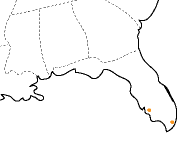Common Wall Gecko
Scientific Name: Tarentola mauritanica / Common Names: Common Wall Gecko
|
Golden vertically slit eyes with red veins give this burly lizard the look of a mythical creature from a Dungeons and Dragons game. Distinct rows of large tubercles shingle the back, pointed tubercles cover the neck and legs, and whorls of tubercles on the tail, give this lizard a spiny, armored appearance. This is another large, robust species, up to 6 in. (15 cm) TL, with a sandy gray coloration, paler at night. The belly is white with overlapping ventral scales. Males are larger, and have broader heads. It has enlarged, undivided toepads and large bulging eyes with a fixed transparent covering.
Habitat and Range The Common Wall Gecko is native to coastal Mediterranean region of Europe and Africa. It has been introduced and established in San Diego County, California, and reported from Lee and Miami-Dade counties, Florida. Habits Little is known about this species in the US, where it is confined to the walls of buildings. It is found in warm, dry coastal regions around the Mediterranean, in stone walls, boulders, and wood piles. It is a good climber, often seen on walls near lights at night, eating insects. Males defend territories, sometimes making squeaking calls. Females lay pairs of eggs. Similar Species The two species of Wall geckos are very similar, both heavily covered with tubercles, and have overlapping shingle-like ventral scales. The Common Wall Gecko lacks the White-spotted Wall Gecko’s two pairs of white spots on the shoulders. Wall geckos lack the Flat-tailed House Gecko’s loose skin flaps and the Fan-footed Rock Gecko’s distinctive, fan-shaped pads. Wall geckos have undivided toepads, whereas the four species of house geckos have divided pads. Bibron’s Thick-toed Gecko has thicker toes, and its ventral scales don’t overlap. Conservation & Other Threats The pet trade is responsible for Common Wall Gecko’s presence in Florida. Such a large predatory species could threaten native lizard or frog populations if it becomes established in natural habitats. This species profile relies heavily on: Arnold & Burton 1978; Bartlett & Bartlett 1999; Mahrdt 1998; Meshaka et al. 2004; Schleich et al. 1996 |
Size:
Habitat:
Active During:
Diet:
Location:
|






